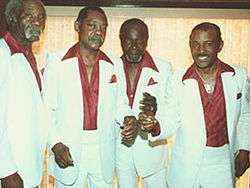The Silhouettes

The Silhouettes were an American doo wop/R&B group whose single "Get A Job" was a number 1 hit on the Billboard R&B singles chart and pop singles chart in 1958. The doo-wop revival group Sha Na Na derived their name from the song's lyrics. "Get A Job"' is included in the soundtracks of the film American Graffiti, Trading Places and Stand By Me. The Silhouettes performed in the 1986 movie Joey.[1]
Career
The Silhouettes were formed in Philadelphia, Pennsylvania in 1956, at first using the name The Thunderbirds. Their classic hit "Get A Job" - originally the B-side to "I Am Lonely" - was issued by their manager Kae Williams on his own Junior Records label before being sold to the nationally distributed Ember label in late 1957.[2] It reached number 1 on both the R&B and pop charts in U.S. and the group performed it on television's American Bandstand.[2] The song sold more than one million copies, and was awarded a gold record.[3]
The lyrics of "Get a Job" are notable for the depiction of a household in tension because of unemployment, despite the man's desperate attempts to find work, all delivered in a relentlessly upbeat style. A second release, "Heading for the Poorhouse", continued the economic theme. It was one of the few songs to allude to inflation, the trip to the poorhouse being because "all our money turned brown". This single and all their subsequent singles sold poorly and the group never entered the national charts again, making them a classic example of "one hit wonders".
The Silhouettes toured with Sam Cooke, Jackie Wilson, Clyde McPhatter and others but the group never reached the top of the charts again. They disbanded in 1968, but the four original members reformed the group in the 1980s and continued to work until 1993.[2]
Group members
- Richard "Rick" Lewis, tenor (September 2, 1933 – April 19, 2005)
- Bill Horton, lead (December 25, 1929 – January 23, 1995)
- Earl T. Beal, baritone (July 18, 1924, Donora, Pennsylvania – March 22, 2001)
- Raymond Edwards, bass (September 22, 1922, Virginia. – 1997, Philadelphia)
- John "Bootsie" Wilson, lead (July 18, 1940 – September 21, 2009)
Sources
References
- ↑ Maslin, Janet (31 January 1986). "Screen: 'Joey,' Rock Tale". The New York Times.
- 1 2 3 Jay Warner, American Singing Groups: A History from 1940 to Today (Hal Leonard Corporation, 2006):290-291.
- ↑ Murrells, Joseph (1978). The Book of Golden Discs (2nd ed.). London: Barrie and Jenkins Ltd. p. 107. ISBN 0-214-20512-6.
External links
- The Silhouettes (tribute site)
- The Silhouettes (Marv Goldberg's R&B Notebook)